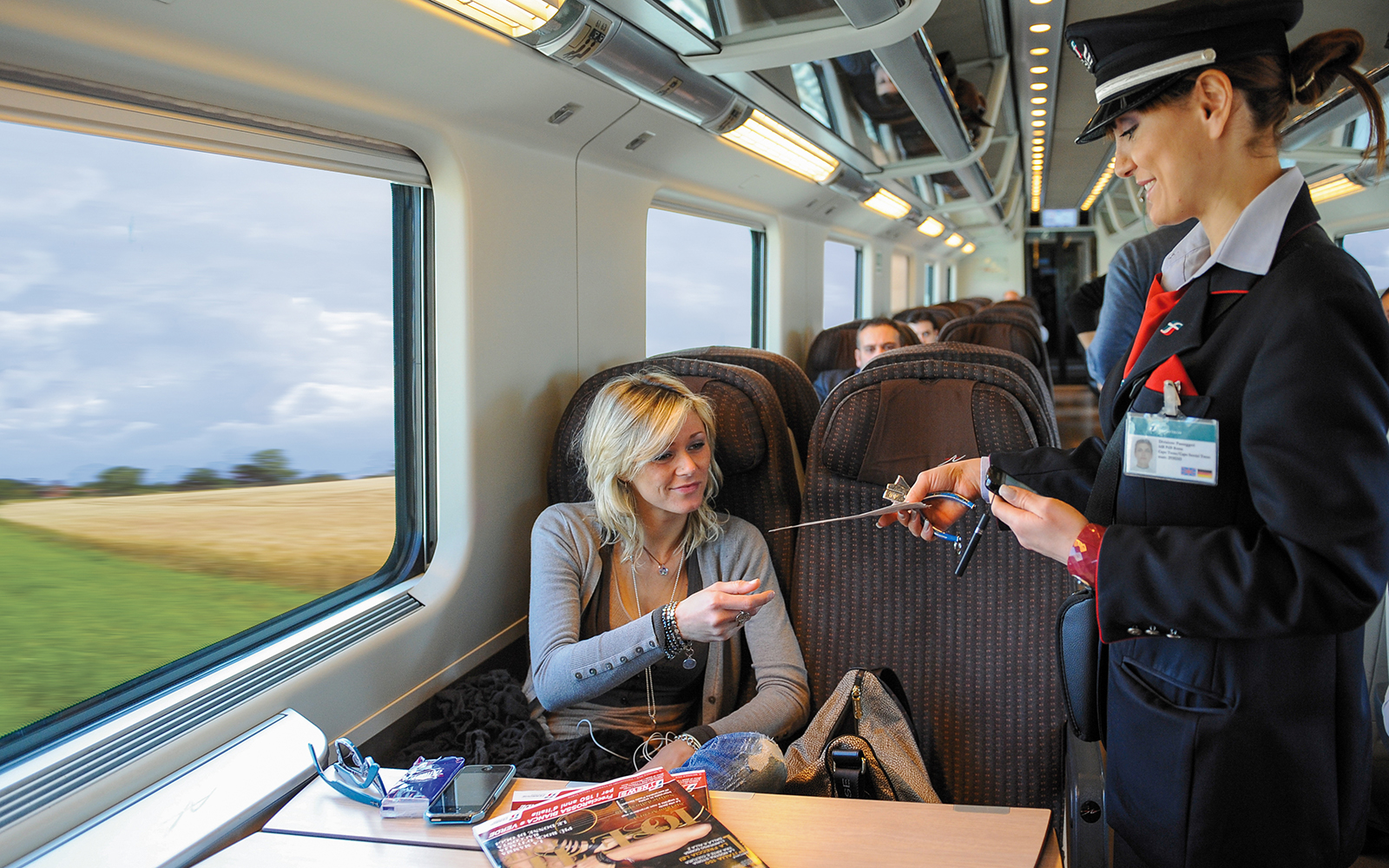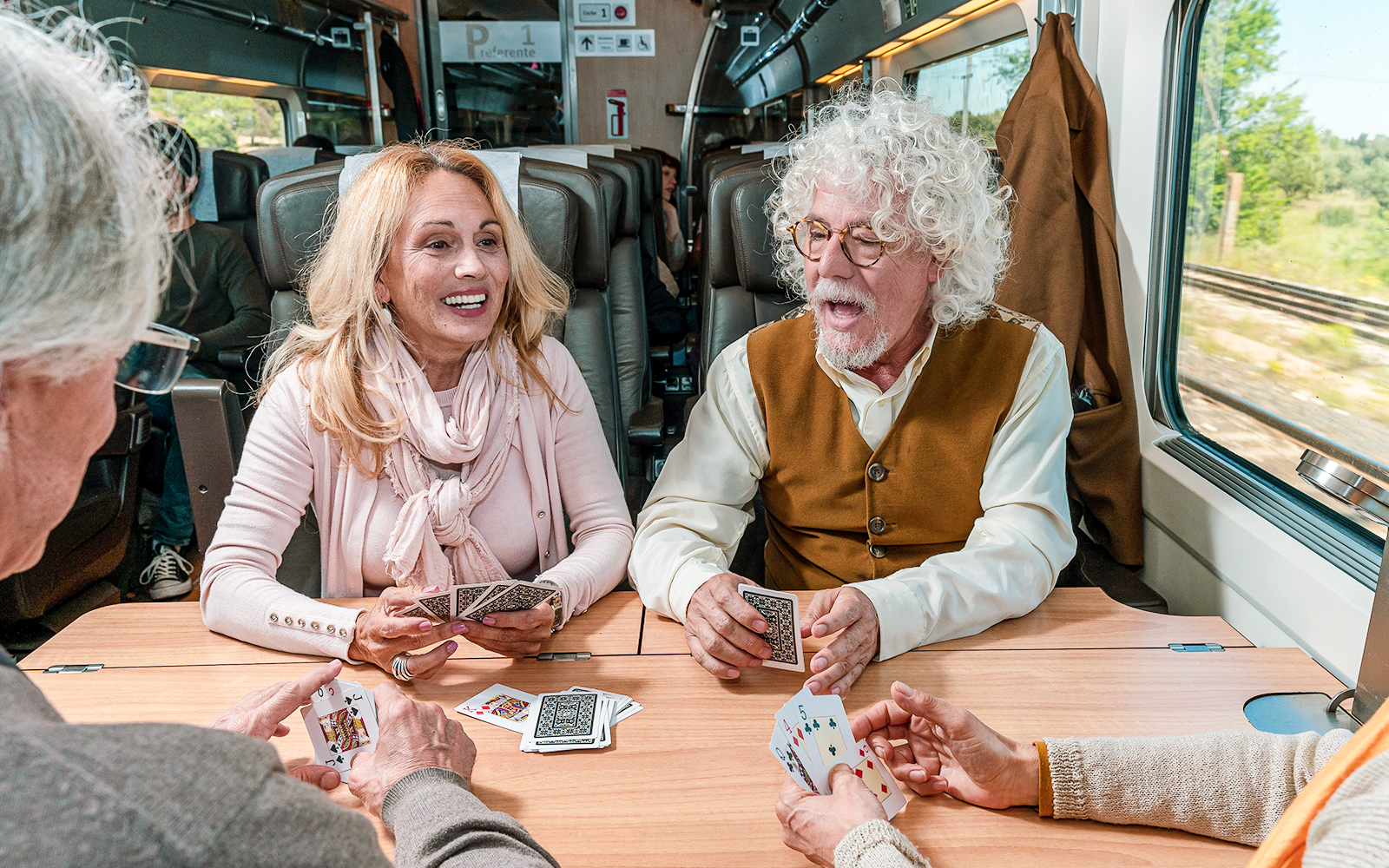Oh, so you’re heading to Europe for a holiday, or you’re in Europe but setting off to explore the continent? Great! And you’re already thinking of a rail pass. Proper planner, you. Now that we know what you’re here for, we’ll tell you all about the Eurail and Interrail Pass which will help you plan the trip even better! After all, there are 33 countries covered by the passes. So much to do, such little time! Let’s get started…

What's a Rail Pass?
First things first. What is a Rail Pass and why does everyone keep talking about it? A Eurail or Interrail Pass isn't just a usual ticket, it’s like a passport to discovering Europe's nooks and crannies at your own pace. These passes offer the freedom to hop on and off trains across 33 European countries. There are various types of passes, but more on that later. But in short, it’s a pass that lets you travel easily, without having to pre-book your ticket. Just shop up at the train station, and set off.
Who can get a Eurail or Interrail Pass

This is aimed at younger travelers aged 12 to 27 years, offering a significant discount compared to the Adult Pass. It’s a popular choice for students, backpackers, and young people traveling on a budget. This means you can travel with a Youth Pass if you start the trip before your 28th birthday.

Children aged 4 to 11 years travel for free with an accompanying adult holding a Eurail or Interrail Pass. This is limited to up to two children per adult. Any additional children require a Youth Pass, but it still represents substantial savings for families. This means they are eligible for this pass until their 12th birthday. Make sure to add this though, when you do buy your own adult pass.
And what about babies? Well, babies don’t need a pass. These important travelers can travel for free and without a pass as long as they are under 3 years. This means they can travel without a Pass if the trip starts before their 4th birthday.
The Rail Pass Dilemma: Is it worth it?
Embarking on a European adventure often brings you to a crossroads: to Eurail/Interrail or not? Here’s a comprehensive guide on whether it is worth it or not, but we’ll break it down for you, just to be clear!
👉 Cost analysis: Point-to-Point vs. Pass
Cost-efficiency over multiple journeys: If you're planning to travel through multiple countries or take several long-distance trips, a Eurail Pass often provides substantial savings over buying individual tickets for each segment, especially when booked last minute. If you plan to cover over 3 countries, or more than 5 cities that are not too close to each other, then you might want to consider a rail pass.
To make it clear, these were prices for off-peak, 2nd class tickets which are significantly less than the 1st class option.
- Ghent to Brussels: €12
- Brussels to Düsseldorf: €90
- Düsseldorf to Berlin: €100
- Berlin to Dresden: €52.50
- Dresden to Prague: €45
- Prague to Český Krumlov: €25
- Český Krumlov (Budejovice) to Linz: €25
- Linz to Salzburg: €30.40
- Salzburg to Vienna: €60
- Vienna to Budapest: €50
- Booking fees: €7 per reservation which means about €70 for all the tickets.
The total is €559. That is already more than the price for the adult, and with the inconvenience of having to buy each ticket separately! See, it's so much more convenient. You also have the flexibility to just show up at the station and hop on a train if you choose! If you're the type to book last minute, then this is much cheaper, as last-minute tickets can be ridiculously expensive!
Reservations fees: The devil is in the details when budgeting for a European train trip. While the pass acts as a master key to most trains, premier services like high-speed, international, and night trains often demand a reservation fee. Countries like Spain, France, Italy, and Sweden are notorious for these additional costs. Navigating this aspect requires foresight and planning.
👉 Planning flexibility
A Eurail or Interrail pass is great if you are looking for a bit of freedom and flexibility. The ability to book trains mere days ahead without financial penalties is a highlight, especially compared to the exorbitant prices of last-minute tickets. This flexibility is the pass's pièce de résistance, catering to the spontaneous and the planners alike. See, it’s a win-win.
👉 Where you are going
The value of a rail pass heavily leans on your chosen path. Venturing through Western and Central Europe, where train travel is king, the pass often presents unmatched value. However, in Eastern Europe, where buses reign supreme in affordability, the scales may tip. The buses are a better and cheaper option, and they are more frequent and well-connected in Eastern Europe.
👉 The added perks of Passes
Beyond the rails, the Eurail/Interrail pass offers multiple perks like discounts on everything from ferries to museums, access to scenic routes such as Bernina Express and Glacier Express, and special pricing for different demographics. This holistic travel experience amplifies the worth of the pass, transcending mere train travel. If you get the First Class Pass, you also get access to the lounges, which have food and beverage free of charge.

Selecting the Perfect Pass:
Choosing the right Eurail/Interrail pass is like selecting the ideal travel companion: it must align with your journey, aspirations, and style!
🌐 Global vs. One Country
Global Pass: This is for the ambitious explorer, offering access to 33 countries. Here’s a map showcasing the extent of your playground.
One Country Pass: Tailored for the deep diver, eager to explore the depths of a single country's culture, cuisine, and countryside, this one is all about spending time in a single country. Residents can't use the One Country Pass in their home country.

🎫 Eurail vs. Interrail
This is actually quite simple. The only difference is where you live. Eurail is designed for non-European residents, while Interrail caters to European residents.
👉 Flexi vs. Continuous
Flexi Pass: The Flexi pass offers travel days within a broader period, ideal for those interspersing train travel with deep city explorations.
Continuous Pass: The Continuous pass, however, is a siren call for the relentless traveler, offering unlimited travel for every day the pass is valid.
Pro Tip: Maximize your Flexi pass by reserving travel days for longer, intercity jaunts. For shorter, regional hops, consider individual tickets.
👉 1st vs. 2nd Class
The choice between classes is a decision of comfort, amenities, and budget. First-class offers a quieter environment and additional perks, while second-class presents a more economical option without sacrificing the essence of the journey. Since first-class seats are usually more expensive, they are also more available. So, booking that means you might find a place on the train more easily. Second-class tickets during peak season can get a bit tricky.
Great, now that you know what pass you need, let’s get to how you can use it most efficiently and effectively. You’re welcome!

How to use your Eurail Pass
The Eurail/Interrail pass is a powerful tool, but wielding it effectively requires knowledge and strategy, which we are going to share right here.
📋 Before You Board
✅ Adding and activating your pass
Your journey begins on the Eurail website or the Eurail Rail Planner app, where you'll add your pass and activate it when your adventure's start date comes close. Here are all the details on exactly how to do this.
Pass Activation: With your pass activated, the European rail network is your oyster. Planning your journey involves selecting your destinations, connecting your trips in the app, and, crucially, understanding when and where reservations are necessary. Here’s a breakdown of how to do that in short.
📱 For Digital Passes:
- Activating Through the App: If you have a digital Eurail or Interrail Pass, activation is done through the Eurail/Interrail Rail Planner app, which can be downloaded from your smartphone’s app store. After purchasing your pass, you’ll receive an email with instructions and a pass code. Enter this code when prompted in the app to add your pass to your digital wallet.
- Setting the Activation Date: In the app, navigate to the section where your digital pass is stored. You should find an option to "Activate" your pass. You’ll be prompted to enter the start date of your travel. This is the date from which your pass will be valid. Note that once set, this date cannot be changed, so choose wisely based on your travel plans. Some passes may require you to enter personal information, such as your passport number, to complete the activation process. Ensure all details match those in your passport.
- Confirmation: Once you’ve entered all required information and selected your start date, confirm the activation. Your pass will now be ready for use from the specified start date. On your travel day, you can show your digital pass via the app to train conductors along with your identification. Ensure your device is charged for the journey.
🎟️ For Physical Passes:
If you've received a physical pass, there’s usually a section on the pass itself where you or a railway official must fill in the start and end date of your pass validity in ink. This must be done before your first train journey. Activation can be done at a train station in Europe. Look for a ticket office where railway staff can validate your pass by stamping it with the start date. They may also fill in the necessary details if not already completed by you. Don’t forget to take your passport with you. Ensure all details are correct and clearly legible before leaving on your journey.
👩💻 Planning and booking your trips:
- Accessing My Trip: First, open the Rail Planner app and navigate to the "My Trip" section. This is where you'll manage all aspects of your journey, from planning to storing specific trip details.
- Creating a New Trip: Within "My Trip," you'll find the option to "Create a Trip." Select this to start planning a new leg of your journey. This feature is incredibly useful for segmenting your travel into manageable parts, such as by country or region.
- Naming Your Trip: After selecting to create a new trip, you'll be prompted to give it a name. Naming your trip can help keep your travel plans organized, especially if you’re exploring multiple destinations. Use clear and descriptive names, like “Swiss Alpine Adventure” or “Italian Riviera,” to easily differentiate between each segment of your travels.
- Plan Your Route: Use the Eurail/Interrail app to plan your journey. It provides real-time train schedules, platform information, and indicates whether reservations are necessary. Always have a backup plan in case your desired train is fully booked or delayed.
- With a Eurail/Interrail Pass, each travel day allows you unlimited rail travel for that day. However, it’s essential to document your journey within the app to have a valid ticket for each travel day. Here’s how to create your daily ticket:
- Find your journey: Begin by picking the specific train(s) you plan to take for your journey. Use the Eurail/Interrail Rail Planner app to find times, routes, and any necessary reservation information.
- Save the journey to your trip: Once you’ve found your specific journey, use the app to save this journey to the "My Trip" section. This organizes your travel plans and prepares them for addition to your Pass.
- Add your journey to your pass: After saving your journey, the next step is to add this journey to your Pass for the relevant travel day. This action generates your daily ticket, which includes all the journeys you’ve added for that day.
- Note: Every travel day on your Pass is unique. The ticket for each day displays all the journeys you’ve incorporated into your Pass for that specific day.
💺 Do I have to reserve a seat?
No, not really. But it makes sense if you are traveling in peak time, or you are already 100% sure which train you are going to be taking. Also, there are some countries whose trains are most crowded and are likely to require reservations. The below are the ones we find definitely need reservations, but make sure you check for all other countries as well!
- France: Almost all TGV high-speed trains require reservations. Due to the popularity of these routes, booking in advance is advisable.
- Italy: High-speed Frecciarossa, Frecciargento, and Intercity trains necessitate reservations. Italy's extensive high-speed network means you'll likely encounter these fees often.
- Spain: Renfe’s high-speed AVE trains, long-distance, and some medium-distance services require reservations. Night trains also have mandatory reservation fees.
- Germany: While most domestic trains (like the ICE) don't require reservations, it's recommended during peak travel times. Night trains often require reservations.
- Switzerland Known for its scenic routes, such as the Glacier Express, reservations are mandatory and come with a fee for these special trains.
👉 How to Make a Reservation:
Open the app and use the ‘Plan’ or ‘Find Train’ feature to search for your journey. Then, enter your departure and arrival stations, travel date and time to check if you need to make a reservation. The app will show this with a symbol or note. If reservations is needed, then just go ahead and “Book Reservation”. Some trains will allow you to pick specific seats while others don’t. Enter your details, payment information (if it’s a paid reservation) and add your journey to ‘My Trip’.
For an in-depth guide to reservations, read here.
🚉 At The Station: Getting on Board
- Arrive Early: Especially if you're unfamiliar with the station, arriving at least 30 minutes before your train departs gives you ample time to find your platform, grab a snack, or use the facilities.
- Check the Departure Boards: Look for your train's departure time and platform number on the electronic boards. In some countries, platforms are announced only a few minutes before departure, so stay alert.
- Validate Your Pass (If Required): In some cases, you might need to get your pass stamped at the ticket office before your first journey or each day you travel. This is increasingly rare with the digital passes but double-check the current requirements.
- Finding Your Seat: If you have a seat reservation, your carriage (coach) number and seat number will be indicated on the reservation. Carriage numbers are usually displayed on the side of the train or indicated on screens along the platform. If you're traveling without a reservation, find a seat in the appropriate class that your pass covers.
🚆 On The Train: Enjoying the Ride
- Pass Inspection: Train staff will periodically check tickets and passes. Keep your Eurail/Interrail Pass, passport (or ID), and any reservations handy for inspection. For digital passes, ensure your device is charged.
- Facilities on Board: Most long-distance and high-speed trains offer dining cars, restrooms, and free Wi-Fi. Familiarize yourself with the train layout to make your journey more comfortable.
- Respect the Train Etiquette: Keep your belongings secure, minimize noise, and be courteous to fellow passengers. Overnight trains often have specific etiquette, especially in shared sleeping compartments.

Expert Tips for Eurail/Interrail Travel
- Economize Your Pass: Leveraging a Flexi pass effectively means knowing when to use it and when not to. Short, inexpensive trips are better served by individual tickets, preserving your precious travel days for the grand adventures. Use travel days for covering significant distances or crossing multiple countries. Longer journeys typically cost more, so utilizing a travel day for such trips ensures you're getting the best value from your pass.
- Early Starts: On days you plan to cover more ground, start early to maximize daylight hours and your pass's value. Evening trains can then whisk you to your next destination or back to your base city.
- Book in Advance: For trains that require reservations, book your seats as early as possible, especially during peak travel seasons or for popular routes.
- Minimize Reservation Costs: Opt for regional trains over high-speed ones when possible to avoid reservation fees. These trains can offer a more local experience and scenic views.
- Avoid Rush Hour: Traveling during off-peak hours can make for a more pleasant journey with more seating options and less crowded trains.
- Leverage Off-Season Travel: If your schedule allows, traveling outside of the peak summer months (July and August) can lead to fewer crowds, cheaper accommodations, and a more authentic experience.
- Travel Light: Space on European trains can be limited, especially during busy times. A smaller, manageable suitcase makes it easier to navigate stations and onboard storage.
- Save on Accommodation: Night trains are an excellent way to cover long distances without losing a day of exploration. They also save you the cost of a night's accommodation.
- Book Sleeper Options: For added comfort, consider reserving a couchette or sleeper car. These come with additional costs but provide beds and sometimes even shower facilities.
- Activation Period: Your pass must be activated within 11 months of the purchase date. Plan your activation date based on your actual travel dates.
- Carry Documentation: Always carry a valid ID (passport for Eurail Pass holders and ID card for Interrail Pass holders) that matches the information on your pass. Conductors may check this along with your activated pass during your journey.
FAQs
Your pass often includes ferry journeys or discounts on certain routes, especially in the Mediterranean and Scandinavia. Check the website for specific companies and benefits to get the exact details.
Continuous passes offer unlimited travel for consecutive days without a pause option. Consider a flexi pass if you want breaks during your travels.
Losing a pass can be stressful. Report it immediately to support for assistance. Replacements might be available, depending on circumstances.
Upgrading is possible in some cases. Contact the relevant train company or customer service to check the terms and availability for an upgrade.
Some buses are covered, especially where trains aren't available. Check the specific coverage for your pass and region.
No, passes are personal and non-transferable. Conductors may check your identity alongside your pass.
Travel on regional trains or book high-speed trains in advance to save on reservation fees. Night trains can offer affordable couchettes.
With a flexi pass, adjust your travel days easily using the Rail Planner app, which provides flexibility for changing plans.
First-class passes offer more space, comfort, and amenities. Consider upgrading if you value a quieter environment or premium services during your journey.
While the pass doesn't cover accommodation, some night trains include sleeper options, saving you a night's lodging. Plus, you might find partner hotels offering discounts to pass holders.
Many European trains allow pets, but each country and operator have different policies. Usually, small pets travel free or with a reduced fare. Always check the rules for your specific journey.




